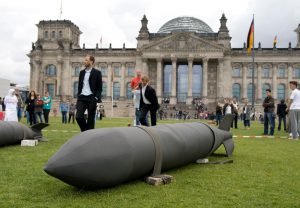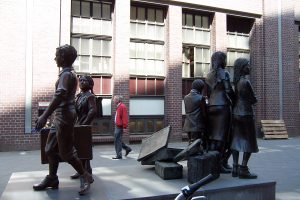This article originally appeared on The Point and has been republished here with their kind permission. David Kretz is a German-born Austrian and a BA 2016 alumnus.

The most compelling political performance artists in Germany do not like to be called “artists.” Nor do they prefer the label of “activists”—a term they reserve for gradualists, clicktivists, and the letter-writers of Amnesty International. Founded in 2009 by the philosopher Philipp Ruch, the Center for Political Beauty makes its base of “operations” (Aktionen in German) in Berlin, with changing groups of volunteers and partners throughout Europe. Its members, who wear suits and charcoal war paint, are organized into “assault teams” aiming to establish “moral beauty, political poetry and human greatness [Großgesinntheit].” They call themselves “aggressive humanists.”
The Center initially made a name for itself when it launched a campaign in the style of “Wanted” posters promising a reward of twenty-five thousand Euros for information leading to the arrest of the von Braunbehrens and Bode families, who share ownership of the arms corporation Krauss-Maffei Wegmann. Controversially, the company had proposed exporting several hundred Leopard 2 tanks to Saudi Arabia. One member of the board stepped down from his post after the exposure, and eventually the deal was abandoned on account of public pressure.
The Center has risen to new national prominence during the recent refugee crisis. In May 2014 the German Ministry for Family Affairs, headed by center-left secretary Manuela Schwesig, announced on a new website that it would offer asylum to fifty-five thousand Syrian children—1 percent of the five million who would need it according to UNICEF. This was in the build-up to the peak of the refugee crisis in 2015, months before Merkel’s exhortation “We can do it.”
The website, which offered online forms for Germans to register as host families, went viral on social media. A video showed happy, grateful children in Aleppo thanking Secretary Schwesig for her initiative. Large crowds spontaneously assembled in front of the offices of the Ministry for Family Affairs in Berlin, celebrating and leaving an ocean of flowers and teddy bears. Such is the political beauty that the Center imagines. It was they who had created the website, as well as a complete Federal Emergency Program, including IT infrastructure, a ready-to-implement legislative framework, extensive PR materials, active hotlines with actors answering questions about the program, and contacts with schools and other organizations inside Syria—a hyper-real theater performance. The Ministry could have played along but chose not to. Embarrassedly and awkwardly, they declared a day later that, no, they would not save the children.
The Center’s English translation of their operation as “Federal Emergency Program” obscures a key point. In German it was called “Kindertransporthilfe des Bundes,” referencing the famous Kindertransport which allowed more than ten thousand children to emigrate from Nazi Germany to Great Britain in 1938-39, which meant that in many cases these children were the only survivors in their families. The term carries a tremendous, positive emotional charge in German and powerfully resonates in the collective memory. Mobilizing such memories has become a signature move of the Center’s work. The worlds they seek to create are utopian—but these utopias are tethered to known historical precedents. In this case the historical reference, while emphasizing an exemplary case of moral beauty and humanity, also draws our attention to the fact that the Kindertransport were an exception. Not entirely unlike today, most countries in the Thirties had reacted to the increased inflow of refugees by tightening their border controls and imposing stricter immigration laws. The Center quotes Chaim Weizmann on their homepage: “The world seemed to be divided into two parts—those places where the Jews could not live, and those where they could not enter.”
As is often the case in the Center’s work, the shining example comes with a warning: to underscore the beauty and nobility of some acts, they contrast them with the cynicism and brutality of others. As part of the Kindertransporthilfe, the Center set up an installation at Berlin’s central Friedrichstrasse Station, close to Frank Meisler’s bronze sculpture “Trains to Life—Trains to Death.“ Meisler’s work commemorates both the ten thousand children who were saved from the camps, and the 1.6 million who were killed in them. The Center set up two blue containers in front of the station with pictures of wounded and mutilated Syrian children. Each picture came with a phone number, which passersby could dial to vote on who should receive asylum and who should not: one in a hundred would be saved, the slogan went—and 99 would not. Nearby was a “medical tent” where Syrian doctors who had fled to Germany would take care of Germans for whom the pictures were too disturbing. While they treated them they told stories of the children they’d had to abandon in the ruins of Aleppo’s bombed hospitals.

Conservative politicians and newspapers voiced criticism. Some objected to the comparison with the Holocaust. Others were concerned that the Center cynically gave false hopes to Syrian children, and that, in any case, one should not take children away from their parents even in war (as was done during the original Kindertransporte). The Center replied that the children were aware they were partaking in a theater play, that vast parts of Syria are currently as safe for children as Germany was for the Jews in 1939, and that it’s better to save some lives than to save none. It was one of their most successful operations. The Office of the Chancellor agreed to a meeting (which the Center had unilaterally announced beforehand). The Center brought along two Holocaust survivors, who had been saved thanks to the original Kindertransporte. Soon thereafter, Germany announced it would take in another ten thousand Syrian refugees.
*****
Last summer, some months after the peak of the crisis, when the initial waves of sympathy towards refugees had begun to wear off, the Center mounted a new operation: in English, the title was “Eating Refugees.” The German language knows two terms for eating: essen, which is what humans do, and fressen, which is what animals do. The German title was “Flüchtlinge fressen” and the animals in question were four fully-grown Libyan tigers. The operation had been launched with an online video explaining that a provision of E.U. law known as §63 prohibits airlines from transporting passengers without valid visas, thereby de facto compelling refugees to have a visa before they can apply for asylum—unless they are willing to risk their lives in a hazardous journey across the Mediterranean Sea. The Center arranged for a plane to transport 115 refugees from Syria to Germany. The plane was baptized Joachim 1, a reference to Germany’s then-president—Lutheran pastor, civil rights activist against the GDR regime, and widely respected moral authority—Joachim Gauck. The historical reference this time was to the Berlin Airlift, a constant stream of airplanes organized by the allies, which brought supplies to keep West Berliners alive when the Soviet Union blocked roads and train connections in 1948. It is another event deeply ingrained in the German collective memory as a shining example of moral greatness, beauty and solidarity.
The Center gave an ultimatum to the German government: permit the plane to land in Germany or several refugees will let themselves be eaten alive by the four tigers, as if in a modern version of a Roman coliseum. The video on their website portrayed Merkel, her Minister of the Interior, and the E.U. as modern-day emperors who would decide—thumbs up, thumbs down—the fates of the Syrian refugees. The subtitle of the operation was Not und Spiele(translated as “Distress and Circuses”), a pun on Brot und Spiele, or panem et circenses. People were again encouraged to vote online as to who should be on the plane and who should not.
Feeding refugees to tigers, it was conceded, is entirely despicable: merely suggesting to do so is utterly tasteless. But then again, the argument went, so are Europe’s policies towards refugees. The operation was merely exposing the brutality that was already being systematically enforced at the continent’s external borders.

Even those generally sympathetic to the Center found the operation hard to stomach. An aggressive humanism surely would still have to be a humanism, and what kind of humanism could even consider feeding humans to tigers? The Center responded by reaffirming their seriousness, and they had the reputation to back up their threats. The tigers were certainly there, in front of the Gorki Theater, for all to see. The first volunteer to be eaten, May Skaf, a Syrian actress, presented herself to the press eight days before the ultimatum ran out. Trembling at times and then again with unsettling calm, she declared that she had been “dead already for a long time.”
The German parliament refused to annul provision §63. The authorities intervened and ordered the airline, who had been told they were transporting “extras in a theater play,” not to fly the plane. But the police did not have to intervene to prevent the suicide by tiger of the twelve Syrian refugees. The tigers had written a letter to the German public, read by May Skaf in front of over a thousand spectators, in which they declared that they were disgusted by human barbarism and did not wish to partake in their uncivilized ecosystem. “It would be wrong to end in the theater, what has not yet ended at all,” they declared.
The Center announced that, together with the 115 refugees, it would sue the German government. Back to legal activism, to procedure and gradual reform? No one was eaten by tigers. Was it thus “merely” theater in the end?
****
“It is easier to enumerate the weaknesses of the operation,” wrote journalist and author Jens Bisky in the Süddeutsche Zeitung “than to treat its topic, the daily deaths on our doorstep, intelligently and effectively.” Yet the operation did seem to leave us hanging in the air, appalled, intrigued, perplexed. In this it mirrored our reaction to the refugee crisis more generally, which finally came to an ambiguous non-end. The stream of refugees decreased, and other topics captured the new cycle, yet the issue remains unresolved.
The Center has since produced only one major operation. Much less spectacular, it did not receive as much attention as Eating Refugees but was provocative nevertheless. The year 2017 marked the 75th anniversary of Hans and Sophie Scholl’s printing of leaflets against the Nazi dictatorship, an act for which they were eventually executed. The Center staged a competition for scholarships by the Bavarian Ministry of Education for high school and college students who were willing to travel to a dictatorship of their choice to print leaflets against the regime. Erdoğan’s Turkey was a principal target, and they installed a printer in Istanbul that automatically threw protest leaflets from a window.
In Germany, they set up an educational program, and a bus toured Bavaria to register students. The historian Wolfgang Benz, winner of the Scholl literary prize, gave a series of lectures on human rights and tyrannicide (their website cites Jefferson on the tree of liberty). A lovingly crafted textbook on the history of anti-dictatorial resistance and the justification of tyrannicide in natural law completes the pedagogical program. It cites Xenophon and Machiavelli, Locke and Tocqueville, Churchill and Bonhoeffer, and, of course, Sophie Scholl. The Center also organized a demonstration, with witnesses of the Nazi era, sporting signs like “Sic semper tyrannis,” “No violence is no solution either,” and, centrally, a quote by Scholl: “Do not hide your cowardice under the cloak of sophistication.”
The German intelligentsia has largely been dismissive, describing their operations as “political pornography,” “simplistic political activism,” and “empty moral heroism.” The Scholl quote might be read as the Center’s summary reply.
Nevertheless, more charitable critics might have questions of their own. An idealism as pure and radical—a humanism as aggressive—as the Center’s cannot but be disappointed again and again. Will the burden of such uncompromising struggle not someday tilt over into despair or cynicism? Has it already led to a Manichean worldview, where all is black and white and nothing gray, leaving only scorn for practically necessary and beneficent compromises? Do such tactics not risk alienating potential allies from the cause? In other words, all the usual questions that sympathetic moderates always have for radicals.
*****
In his 2015 book-length manifesto Who, If Not Us? (Wer, wenn nicht wir?), Philipp Ruch gives us his rationale for the Center’s operations. Despite the fact that most of the Center’s enthusiasts come from the political left, Ruch has little use for the left’s usual categories of criticism. He believes ideas (not money or power) are the primary determinants of history. Some ideas Ruch calls “toxic”: they paint a picture of humans as weak, ugly and animalistic rather than powerful, beautiful, and aspiring to the divine. He finds the most toxic ideas in the works of Hobbes, Darwin and especially Freud, as well as in all kinds of scientistic reductionism, materialism and determinism. For Ruch, who wrote his Ph.D. on ancient philosophy and law, the good and beautiful counter-ideas are to be found primarily in the works of the ancient Greeks: Homer, Plato, Aristotle and Pindar.
Ruch views modernity and egalitarian democracy with suspicion. Citing Leo Strauss, he accuses contemporary society of championing mediocrity, and thereby of being incapable of producing truly heroic human rights activists. He thinks totalitarianism, not capitalism, is the greatest evil of our times, and praises the heroism of military interventions against dictators. It would go too far to call him a fascist, as some left-wing critics have done. But Ruch’s humanism is neither the post-heroic humanism of liberals, nor the class-conscious humanism of Marxists. Nor is it the Christian humanism that turns the other cheek in this life and hopes for its reward in the next. In the worldview of the ancients, Ruch discovers an idea of man as approaching the divine through heroic extremes. In noble and beautiful deeds, this man discovers his sanctity and his highest humanity.
As the philosopher Bernard Williams has noted, the avoidance of public shame is central to Greek ethics, whereas modern morality turns on the more legalistic, and often private, dynamics of guilt. True to its intellectual models, shame is at the heart of Ruch’s work. One of the Center’s earliest works was a Pillar of Shame to commemorate the failures of the UN in Srebrenica. Later operations, like the Kindertransporthilfe, were meant to shame European institutions and governments. Most importantly, however, and from the beginning, the operations aimed to provoke shame in us, the audience. Very few people in the Center’s audience feel personal guilt about the deaths of refugees at Europe’s external borders. But as members of historical communities committed to ideals of universal human dignity—as Germans, as Europeans, as Westerners—we may all be made to feel ashamed at those deaths. They remind us how we fail to live up to what is best in our heritage and repeat what is worst.
Yet the Greek example also brings out the distance between the Center’s ideas and the ancients’ worldview. The inventors of tragic theater expressed a profound skepticism about the ability of human beings to limit the influence of cruel necessity and chance. The Center, in this respect, could not be less Greek. They exhort their audience to shudder not at the dark workings of ineluctable fate, but to show indignation at the shameful, because unnecessary, failure of human institutions and citizens to halt suffering and injustice. Their willingness to meet the world, even at its worst, with unyielding resolution, may strike us as Homeric. But their faith that the sources of calamity are ultimately correctible by human effort expresses a hope that delineates them as essentially modern.
Taking the Greeks seriously, it is tempting to point out, would mean recommending that the Center develop a sense of tragedy—or at least a sense of Socratic irony, which combines commitment to truth and justice with an acknowledgment of our mortal finitude. Yet in this world of clicktivists, letter-writers, and late-night satirists, I cannot help finding something marvelous—and beautiful—in the Center’s heroically aggressive, and thoroughly modern, idealism.
